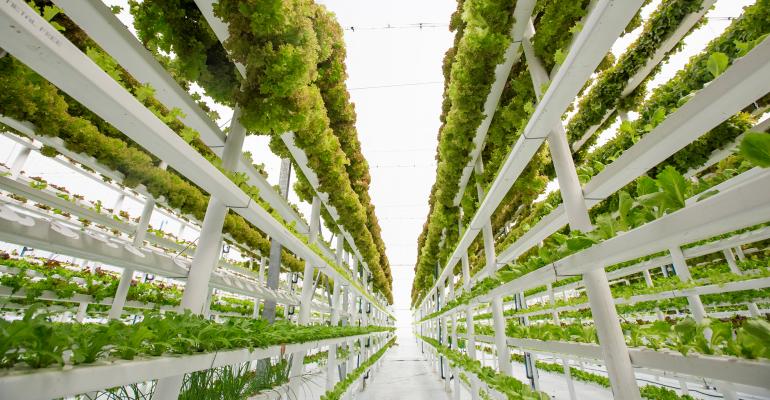“Inclusive and sustainable development.” That’s how Alberto Rincon, director of Community Planning for The Invert in Chicago, describes the future of the industrial real estate sector, as embodied in this proposed and ultra-green development project. From vertical farming to light manufacturing, The Invert, at six million net sq. ft.—all underground—may set the gold standard for industrial real estate when it opens for business in 2025, just as The Edge in Amsterdam set the gold standard for environmentally advanced office development several years ago.
If the project gets off the ground (not a very big “if,” given that the SubTropolis in Kansas City is already open for business), it would be at a pivotal time in the industrial growth cycle. Projects such as this set the stage for an advanced awareness of what a sustainable approach can create in this traditionally pollutive sector.
It also comes at a time when industrial real estate, generally speaking, is blazing hot. Indeed, the roughly 2,000 IREM members (about 10 percent of total IREM membership) who manage these properties are riding a wave of growth spurred in large part by the explosion of e-commerce and same-day delivery expectations of the past year. From the perspective of business dynamics, the explosive rise of industrial manufacturing and warehousing was one of the few benefits that arose from the collective bad news ashes of the COVID-19 pandemic.
Let’s look to the stats for proof. According to JLL’s industrial outlook, “Leasing momentum and demand for industrial space continues to forge ahead. In this quarter [Q1] alone, over 121.5 million square feet of industrial product was leased.” It goes on to pinpoint rent growth as high as $6.39 a sq. ft., and national net absorption of 85.6 million sq. ft. Meanwhile, vacancies are at basement levels of under six percent.
Industrial, of course, was already a solid performer prior to the upheaval of 2020. But last year saw an amazing spike in internet sales, home shopping and goods delivered without the risk of venturing out to shop while armed with masks and hand sanitizer. In fact, Supermarket News reports a 300 percent spike in online grocery sales in the early months of the pandemic. And the popularity of food delivery apps doubled.
Amazon, of course, is the 800-pound virtual gorilla in the room, gobbling up space faster than any provider with its focus largely on top tier space, leaving close to obsolete B/C assets looking a lot more attractive to tenants in need of space.
And the good news only promises to get better. “Demand for space in the near term will be driven by e-commerce,” according to CBRE Research, which calculates that $1 billion in e-commerce sales computes to 1.25 million sq. ft. of warehouse demand.
“Therefore, net absorption is projected to reach nearly 250 million square feet in 2021, more than the previous five-year annual average of 211 million feet,” CBRE goes on to say. “This will spur new construction, which is already near record levels, and strong pre-leasing of speculative projects.”
It’s a good time to be in industrial real estate management. From my company’s own experience, as well as from IREM membership in industrial management, what might surprise property managers in other asset classes is that the interaction between property manager and tenant in industrial real estate is relatively light. This is due in large part to the double- or triple-net lease arrangements that are common in the sector.
Much of the property manager’s job is focused on shell and infrastructure issues, such as the care and maintenance of sprinklers. And this brings us back to the sustainability issue. As an example, in one of Watts Realty’s managed buildings, one specialized warehousing company had a need for high-pressure sprinklers. The problem was, when they went off—and they did indeed go off once—the amount of pressure needed was so great it left municipal hydrants bone dry.
This is a serious problem for tenants who are driven out of more robust infrastructure markets to B/C localities, where services outside of the building itself might be challenged. It’s a sign of a tight market for industrial space, and a reflection of the need for more robust infrastructure development, suitable enough for the local purpose.
As an organization, IREM is trying to do our part through education and communication, to raise awareness of the potential for more sustainable approaches in the sector. IREM’s Certified Sustainable Property Program (CSP) has a track designed specifically for industrial assets. As the real estate community returns to normal, and the issue of the environment once again gains a prominent position in our strategies, I urge all members, certainly not only those in this advancing sector, to engage in the program.
With the growth prospects for industrial real estate ahead of us, we, as real estate managers, have an opportunity to make it even better.
Chip Watts, CPM, CCIM, C2EX, AHWD, is the 2021 president of the Institute of Real Estate Management. In addition, he serves as president and executive CPM for Watts Realty Co. Inc. in Birmingham, Ala.

